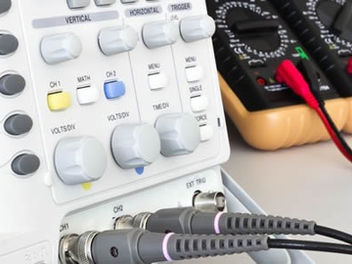How Often Should Schools PAT Test?
- Guy hudson
- Jan 10, 2024
- 4 min read
Within the educational landscape, prioritising electrical safety reigns supreme, and Portable Appliance Testing (PAT Testing) emerges as a crucial shield in this domain. This meticulous process isn't just a routine check; it's a meticulous examination of the lifeblood of educational spaces—the electrical equipment. By scrutinising and validating these devices, PAT Testing ensures their safety and compliance with regulations, nurturing an environment conducive to learning and devoid of potential electrical hazards.
The significance of PAT testing in school settings goes beyond mere compliance; it's a safeguarding ritual for the very essence of a secure educational milieu. From the computers powering knowledge to the kitchen appliances fueling nourishment, every piece of electrical equipment within school premises undergoes the scrutiny of PAT testing, ensuring they bear the hallmark of safety as a PAT tested electrical appliance.
Understanding the intricacies of this process isn't just a matter of compliance; it's a responsibility to uphold the sanctity of learning spaces. Determining the optimal testing frequency isn't merely a bureaucratic exercise; it's a tailored approach to ensuring that electrical safety remains at the forefront, fulfilling the legal requirement and ensuring that the school's electrical appliances meet the Class II safety standard.
What Does PAT Testing Involve?
PAT testing encompasses a thorough examination of electrical equipment to ensure it meets safety standards. It involves visual inspections, earth continuity checks, insulation resistance tests, and functional checks. The goal is to identify potential hazards and mitigate risks associated with faulty or deteriorating electrical appliances.
Factors Influencing PAT Testing Frequency
Usage and Conditions of Electrical Installations
The frequency of PAT testing heavily relies on how frequently electrical equipment is used and the environments they operate in. High-usage areas like computer labs or kitchen facilities might require more frequent testing due to increased wear and tear. Similarly, equipment used in harsher conditions or exposed to more risk factors may also necessitate more frequent assessments to ensure ongoing safety and compliance.
Environment and Infrastructure
The surroundings and infrastructure of a school play a significant role in determining PAT testing frequency. Factors such as dampness, dust, temperature fluctuations, and other environmental considerations impact the wear and tear on electrical equipment. Schools situated in areas prone to extreme weather conditions might require more frequent testing to counteract potential damages caused by environmental factors.
Manufacturer Recommendations and Industry Standards
Manufacturers often provide guidelines regarding the optimal testing frequencies for their electrical equipment. These recommendations, aligned with industry standards, offer valuable insights into the expected lifespan and maintenance needs of devices. Adhering to these guidelines ensures that the equipment operates safely within the parameters outlined by the manufacturer and industry standards, contributing to a safe and compliant environment within schools.
Devices and Equipment Subject to PAT Testing
All electrical appliances used in schools, from computers to kitchen equipment, fall under the scope of PAT testing. Expanding on the scope of devices and equipment subject to PAT testing within schools involves recognising the extensive gamut of electrical appliances. From the omnipresent computers powering knowledge dissemination to the kitchen equipment orchestrating culinary endeavours, virtually every electrical device within school precincts falls under the purview of PAT testing. This encompassing assessment ensures that each device aligns with stringent safety standards, securing the educational environment from potential electrical hazards.
A PAT-tested electrical appliance, emerging from this rigorous evaluation, proudly wears its badge of compliance. Every device, whether it's an essential teaching aid or a utility device, undergoes meticulous scrutiny, to ensure its safety and compliance. Crucially, these appliances bear the emblematic label, a testimony to their tested status and a reminder of their safety compliance. This label proudly displays the testing date, affirming the equipment's compliance with safety regulations, and instilling confidence in users and custodians alike.
Recommended Frequency for Schools
General Guidelines and Standards
The IET Code of Practice recommends that electrical equipment in schools should undergo PAT testing every 2-4 years. However, some equipment, especially those with a higher risk of damage or wear, may require more frequent testing.
Tailoring PAT Testing Frequency for Schools
To tailor the testing frequency for schools, it is essential to consider the type of equipment, its location, and the level of usage. High-risk equipment, such as those used in science labs, may require more frequent testing, potentially annually.
Case Studies or Examples of PAT Testing Schedules
Examining case studies of schools with successful PAT testing schedules can serve as a practical guide. Schools can learn from others' experiences to create a customised testing plan that suits their unique circumstances and ensures ongoing electrical safety.
Conclusion
PAT testing stands as a vital pillar in upholding electrical safety within the school environment. Aligning with legal requirements, understanding the nuanced guidelines, and tailoring testing frequencies to suit individual school needs collectively form the foundation of an effective electrical safety strategy. Embracing PAT testing isn't just about compliance; it's about fostering a secure haven for everyone within school premises.
Navigating the intricate landscape of electrical safety in educational institutions demands expertise and precision. That's where partnering with professionals like Global Compliance UK, Your Electrical Safety Partner, becomes pivotal. With over 25 years of unwavering dedication, they offer comprehensive nationwide services, ensuring that your school's PAT testing needs are met with unparalleled efficiency and expertise.
As you prioritise the safety of students, staff, and visitors, consider entrusting your school's electrical safety to the seasoned hands of Global Compliance UK. Contact them at info@global-compliance.co.uk or call 0330 100 5341 to initiate a robust electrical safety plan tailored specifically to your school's needs. Remember, beyond being a responsibility, electrical safety is a commitment to fostering a secure learning environment for the future. Choose safety; choose Global Compliance UK.



























Comments